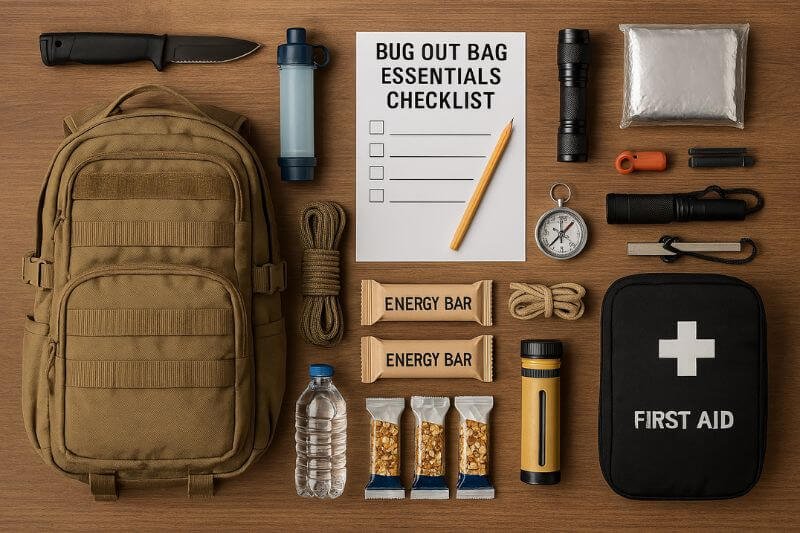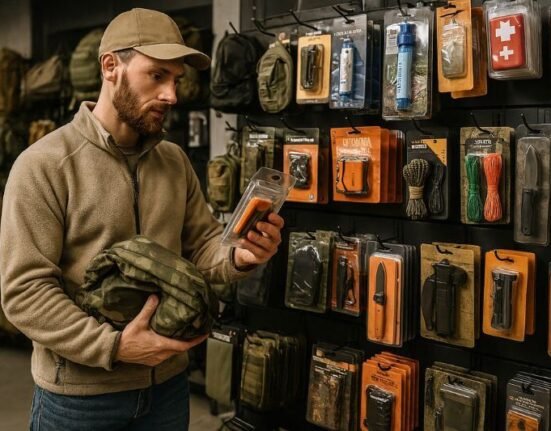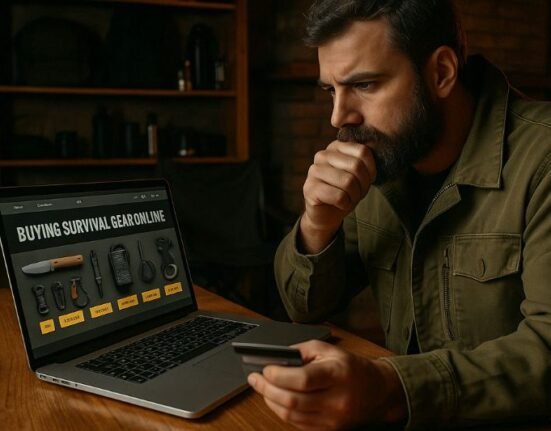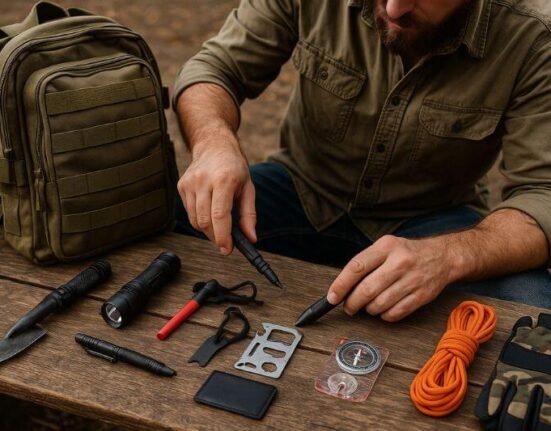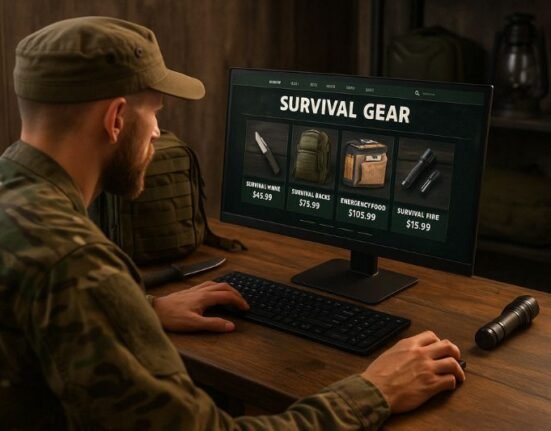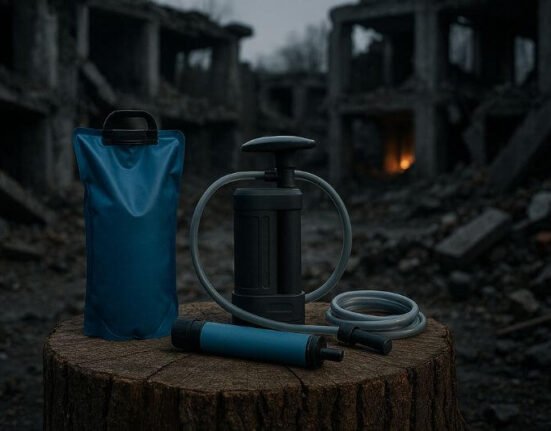When disaster strikes, your bug out bag essentials can determine whether you survive or struggle. In the first moments of an emergency, you won’t have time to think — only time to move. That’s why your bag needs to be lean, effective, and built for your real-world needs.
In this expert guide, we’ll break down what you truly need in your bug out bag — and what’s just dead weight. No fluff, no fantasy gear — only survival-critical truth.
Why Your Bug Out Bag Can Make or Break Your Survival Plan
The purpose of a bug out bag (BOB) is simple: allow you to evacuate quickly with everything you need to survive for at least 72 hours. But many preppers make the same mistake — they overload their bags with non-essential gear or survival gadgets they’ve never tested.
“A good bug out bag should support survival, not sabotage it.” — Urban Survival Institute, 2023
Let’s separate the must-haves from the myths.
1. Core Categories of Bug Out Bag Essentials
To build an effective bug out bag, think in survival priorities. These five categories should guide every item in your pack:
The 5 Survival Priorities:
- Water
- Food
- Shelter
- Medical
- Security
Every item should directly support one of these. Anything else? Question its value.
✅ Rule of thumb: If it doesn’t serve a purpose in the first 72 hours, it probably doesn’t belong in your BOB.
2. The Real Must-Haves: What You Actually Need
Let’s get into the gear that every serious prepper should carry — no matter their location, climate, or skill level.
🔹 Water & Hydration
- Collapsible water bottle or canteen
- Portable filter (e.g. Sawyer Mini, LifeStraw)
- Water purification tablets (backup)
💡 Tip: Plan for at least 1 liter per person per day — and don’t rely on just one purification method.
🔹 Emergency Food
- High-calorie energy bars (dense and light)
- Freeze-dried meals or MREs
- Collapsible stove or fire-starting tools (if cooking required)
🔥 Avoid bulky canned goods. They’re heavy and spoil quickly once opened.
🔹 Shelter & Warmth
- Lightweight tarp or bivvy sack
- Mylar emergency blanket
- Compact sleeping pad or inflatable mat
- Poncho or rain gear
“Shelter from wind, cold, or rain will save more lives than a second multitool.” — Red Cross Field Notes
🔹 First Aid Kit
- Trauma supplies (tourniquet, gauze, pressure bandage)
- Adhesive strips, antiseptic wipes
- Painkillers, antihistamines, burn cream
- Tweezers, gloves, shears
✅ Pro Tip: Add a printed first aid reference sheet in case you’re panicked or injured.
🔹 Security and Self-Defense
- Fixed-blade survival knife
- Pepper spray (legal and effective)
- Tactical flashlight (blinding beam + self-defense use)
- Loud whistle for signaling
🛡️ Firearms depend on training, legality, and personal comfort. Consider carefully.
🔹 Communication & Navigation
- Hand-crank radio (NOAA-enabled)
- Two-way radio (GMRS/FRS)
- Compass + local topographic map
- Waterproof notepad + pencil
📡 Never assume you’ll have GPS. Practice offline navigation now.
🔹 Clothing (Climate-Specific)
- Extra socks and underwear
- Layered clothing system (base, mid, waterproof shell)
- Beanie or hat, gloves
- Comfortable hiking shoes (broken-in!)
🔹 Tools & Multipurpose Gear
- Paracord (at least 25 ft)
- Multitool (pliers, blade, screwdrivers)
- Duct tape (mini-roll)
- Zip ties
- Small signal mirror
🧰 Lightweight tools that do more than one job are gold in survival.
3. Common Useless Items That Weigh You Down
Let’s be honest — many “prepper” guides on the internet push gear that’s impressive in theory, useless in practice. Here’s what to leave out:
🚫 Gear to Avoid:
- Full-sized hatchets (too heavy for most BOBs)
- Huge survival guides (print essentials only)
- Cooking pots (unless you plan to bug out for >5 days)
- Glow sticks (short lifespan, low visibility)
- Camp showers or collapsible sinks
- Non-prescription drugs you never use
“Don’t pack fantasy gear. Pack experience-tested tools.” — Field Prep Review, 2022
4. Urban vs. Wilderness Bug Out Bags: Key Differences
Your location matters. An urban BOB is very different from a rural or wilderness setup.
| Feature | Urban BOB | Wilderness BOB |
|---|---|---|
| Emphasis | Stealth, mobility | Shelter, tools |
| Colors | Gray, black (low-profile) | Earth tones |
| Navigation | Local maps, subway routes | Compass, topographic maps |
| Shelter | Compact poncho | Tarp or tent |
| Defense | Discreet tools | Visible deterrents |
🗺️ Checklist Tip: Adjust your bag seasonally and by threat level.
5. How to Pack Your Bug Out Bag Like a Pro
A great BOB is more than just gear — it’s about smart packing.
📦 Packing Strategy:
- Heavy items close to your spine
- Most-used items (flashlight, knife, radio) in external pockets
- Use dry bags or ziplocks for weatherproofing
- Label pouches for quick access (e.g. “MED,” “FIRE,” “NAV”)
🎒 Test your bag on a 3-hour hike. If it hurts or shifts too much, repack.
6. Real-World Bug Out Mistakes to Avoid
Here’s what many beginners get wrong — and how to fix it:
❌ Top Mistakes:
- Packing 3 days of food but 1 day of water
- Forgetting personal medications
- Carrying a firearm without knowing the law
- Using a cheap backpack that tears under load
- Assuming you’ll “learn on the go”
✅ Best practice: Run an annual bug out simulation — ideally in different seasons.
7. Maintain, Rotate, and Test Your Bug Out Bag
A bug out bag is not a “set it and forget it” tool. Contents expire, batteries die, climates change, and your needs evolve.
📅 Regular Maintenance Checklist:
- ✅ Check food & water expiration dates (every 6 months)
- ✅ Rotate medications and hygiene items
- ✅ Recharge power banks and test flashlights
- ✅ Replace worn-out or damaged gear
- ✅ Adjust clothing and shelter gear by season
💡 Pro tip: Set a calendar reminder every 6 months to reassess your bug out bag.
8. Personalization: One Size Does Not Fit All
No two bug out bags should be identical. Your pack should match:
- Your location (urban vs. rural)
- Your body type & fitness level
- Your weather/climate
- Your medical needs
- Your skillset
🧠 For example:
- A diabetic prepper needs insulin storage.
- A single woman in a city may prioritize stealth and deterrence.
- A rural prepper may include fishing kits or trapping gear.
🎒 Adapt your gear to your reality — not someone else’s fantasy loadout.
9. Sample Bug Out Bag Checklist (72-Hour Standard)
| Category | Essential Items |
|---|---|
| Water | Filter, purification tabs, 2L container |
| Food | 3,000+ calories, MREs, bars, stove |
| Shelter | Mylar blanket, tarp, bivvy sack |
| Fire | Ferro rod, lighter, waterproof matches |
| First Aid | Trauma kit, meds, antiseptics |
| Tools | Knife, multitool, paracord, duct tape |
| Clothes | Underwear, socks, gloves, weather protection |
| Navigation | Compass, maps, notepad |
| Comms | Hand-crank radio, whistle, 2-way radio |
| Defense | Pepper spray, flashlight, legal tools |
| Hygiene | Toothbrush, wipes, sanitizer |
| Documents | Copies of ID, insurance, emergency plan |
📎 Imprime cette checklist, plastifie-la, et glisse-la dans ton sac.
10. Internal Links to Deepen the Guide
🔗 How to Build a 3-Tier Survival Supply System (Home, Vehicle, EDC)
🔗 Top 25 Survival Supplies Every Beginner Prepper Needs
🔗 Bug Out vs INCH Bag: Which Is Right for You?
🔗 Top Mistakes Beginner Preppers Must Avoid
Conclusion: Your Bug Out Bag Is Your Emergency Lifeline
Your bug out bag essentials are your first line of defense in a crisis. It must be tested, tailored, and trimmed for speed and reliability.
Forget trendy survival gadgets and focus on the core needs: water, food, shelter, security, and health. Make it light. Make it mobile. Make it yours.
👉 Next Step:
Download our Ultimate Printable Bug Out Bag Checklist and start building or auditing your own BOB today.
Prepping isn’t paranoia — it’s proactive survival.
FAQ: Bug Out Bag Essentials
How heavy should my bug out bag be?
No more than 15-20% of your body weight. Lighter is better. Comfort = endurance.
Should I pack a tent?
Only if it’s compact and lightweight. A tarp or bivvy is often more versatile and faster to set up.
How many days should my bug out bag cover?
Standard = 72 hours (3 days). For longer-term evacuation, consider supplementing with INCH bags.
Can I buy a pre-made bug out bag?
Yes, but always audit it. Most “pre-made kits” include low-quality gear or miss essentials.









